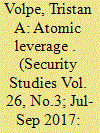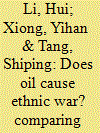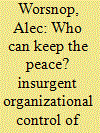|
|
|
Sort Order |
|
|
|
Items / Page
|
|
|
|
|
|
|
| Srl | Item |
| 1 |
ID:
153181


|
|
|
|
|
| Summary/Abstract |
Nuclear proliferation is not a binary outcome with uniform consequences, but instead spans a continuum of latent capacity to produce nuclear weapons. At various thresholds of technical development, some countries leverage nuclear latency to practice coercive diplomacy. How and when does nuclear technology provide a challenger with the most effective means to extract concessions in world politics? This article claims that compellence with nuclear latency puts a challenger on the horns of a credibility dilemma between demonstrating resolve and signaling restraint, and identifies a sweet spot for reaching an optimal bargain where the proliferation threat is credible while the assurance costs of revealing intent are low. Historical studies of South Korea, Japan, and North Korea validate this Goldilocks principle and find that it consistently reflects the ability to produce fissile material. Contrary to conventional wisdom about proliferation, nuclear technology generates political effects long before a country acquires nuclear weapons.
|
|
|
|
|
|
|
|
|
|
|
|
|
|
|
|
| 2 |
ID:
153174


|
|
|
|
|
| Summary/Abstract |
This article contributes both empirically and methodologically. Empirically, we seek to advance our understanding of an important puzzle: does oil cause ethnic war? Methodologically, we seek to identify more precisely the different weaknesses and strengths of the quantitative approach and case studies with process-tracing by explicitly comparing results from these two approaches on the same empirical question. We thus subject the statistical association between the ethnogeographical location of oil and the onset of ethnic war to test with process-tracing. Examining several pathway cases, we find that oil has rarely been a deep cause of ethnic war. Instead, the ethnogeographical location of oil either reignites dormant conflict that has deeper roots in ethnic resentment and hatred or intensifies ongoing conflict, mostly by facilitating the operation of two interconnected mechanisms. Our study echoes the notion that quantitative exercises alone often cannot establish specific causal mechanisms or how contextual factors impact the operation of these mechanisms, and it is precisely on these two key fronts that qualitative exercises possess critical advantages. Hence, quantitative methods and qualitative methods are complementary rather than competitive. Our study also yields important policy implications for preventing and managing ethnic conflict in countries with rich mineral resource.
|
|
|
|
|
|
|
|
|
|
|
|
|
|
|
|
| 3 |
ID:
153178


|
|
|
|
|
| Summary/Abstract |
What are the dynamics of coercion in cyberspace? Can states use cyber means as independent tools of coercion to influence the behavior of adversaries? This article critically assesses traditional coercion theory in light of cyberspace's emergence as a domain in which states use force, or its threat, to achieve political objectives. First, we review the core tenets of coercion theory and identify the requisites of successful coercion: clearly communicated threats; a cost–benefit calculus; credibility; and reassurance. We subsequently explore the extent to which each of these is feasible for or applicable to the cyber domain, highlighting how the dynamics of coercion in cyberspace mimic versus diverge from traditional domains of warfare. We demonstrate that cyber power alone has limited effectiveness as a tool of coercion, although it has significant utility when coupled with other elements of national power. Second, this article assesses the viability and effectiveness of six prominent warfighting strategies in the traditional coercion literature as applied to the cyber domain: attrition, denial, decapitation, intimidation, punishment, and risk. We conclude that, based on the current technological state of the field, states are only likely to achieve desired objectives employing attrition, denial, or decapitation strategies. Our analysis also has unique implications for the conduct of warfare in cyberspace. Perhaps counterintuitively, the obstacles to coercion that our analysis identifies may prompt states to reevaluate norms against targeting civilian infrastructure.
|
|
|
|
|
|
|
|
|
|
|
|
|
|
|
|
| 4 |
ID:
153175


|
|
|
|
|
| Summary/Abstract |
Although hundreds of thousands of soldiers from different national contingents are deployed every year in multinational peace operations, no previous study has examined differences in peacekeeping practices along national lines. This paper first documents systematically differences in the way national contingents behave during peace operations in their respective area of operation. In a second step, it argues that these differences in behavior are largely consistent with the most important traits of each army's military culture. Based on extensive fieldwork conducted between 2007 and 2014 in Lebanon and Afghanistan, the paper shows how, within each mission, Italian soldiers prioritized humanitarian activities, while the French engaged in more patrolling activities, despite being both contingents deployed under similar conditions. These variations in behavior are consistent with the way French and Italian soldiers perceive the mission and context in which they deployed. And both the differences in behavior and perception are in line with the respective armies' military cultures. This paper contributes to the debate on the role of ideational factors in international politics and in particular to the ongoing discussion on strategic and military cultures.
|
|
|
|
|
|
|
|
|
|
|
|
|
|
|
|
| 5 |
ID:
153177


|
|
|
|
|
| Summary/Abstract |
Despite a few persistent, high-profile conflicts in the Middle East, the world is experiencing an era of unprecedented peace and stability. Many scholars have offered explanations for this “New Peace,” to borrow Steven Pinker's phrase, but few have devoted much time to the possibility that US hegemony has brought stability to the system. This paper examines the theoretical, empirical, and psychological foundations of the hegemonic-stability explanation for the decline in armed conflict. Those foundations are rather thin, as it turns out, and a review of relevant insights from political psychology suggests that unipolarity and stability are probably epiphenomenal. The New Peace can in all likelihood continue without US dominance and should persist long after unipolarity comes to an end.
|
|
|
|
|
|
|
|
|
|
|
|
|
|
|
|
| 6 |
ID:
153179


|
|
|
|
|
| Summary/Abstract |
Every armed organization seeks the ability to turn violence on and off by getting fighters to fight when ordered and to stop fighting when similarly ordered. This ability is a defining feature of what makes organized violence, in fact, organized. While state militaries develop clear hierarchies and disciplinary procedures to accomplish this goal, the complexity of civil war makes the task more difficult for insurgent groups. I argue that the leaders of insurgent organizations are able to turn violence on and off when they have deliberately established resource control through the direct, and exclusive, distribution of resources to their followers and those followers are socially embedded, meaning that members are united by strong horizontal ties and group norms. In contrast to existing approaches, I argue that material and social endowments do not predetermine whether leaders can establish resource control or embeddedness. Further, laying out the precise organizational mechanisms that determine when organizations can turn violence on and off challenges the utility of conceptions such as “fragmentation” or “cohesion” for explaining insurgent behavior and conflict outcomes. I test the theory by examining variation in behavior over time in two organizations facing different structural contexts—Jaysh al-Mahdi in Iraq and the Viet Minh in Vietnam—and find strong support for my argument while casting doubt on existing explanations.
|
|
|
|
|
|
|
|
|
|
|
|
|
|
|
|
|
|
|
|
|